Lincolnshire
| Lincolnshire | |
|---|---|
 Flag |
|
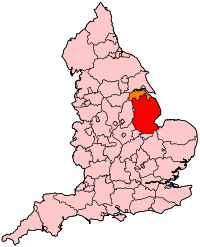 |
|
| Geography | |
| Status | Ceremonial & (smaller) Non-metropolitan county |
| Region | East Midlands (North Lincolnshire and North East Lincolnshire are in Yorkshire and the Humber) |
| Area - Total - Admin. council - Admin. area |
Ranked 2nd 6,959 km2 (2,687 sq mi) Ranked 4th 5,921 km2 (2,286 sq mi) |
| Admin HQ | Lincoln |
| ISO 3166-2 | GB-LIN |
| ONS code | 32 |
| NUTS 3 | UKF30 |
| Demography | |
| Population - Total (2008 est.) - Density - Admin. council - Admin. pop. |
Ranked 18th 1,016,600 146 /km2 (380 /sq mi) Ranked 14th 698,100 |
| Ethnicity | 98.5% White |
| Politics | |
Lincolnshire County Council http://www.lincolnshire.gov.uk/ |
|
| Executive | Conservative |
| Members of Parliament | |
| Districts | |
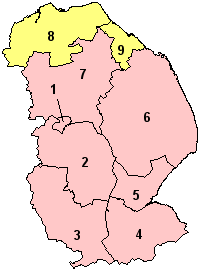
|
|
Lincolnshire (![]() /ˈlɪŋkənʃər/ or /ˈlɪŋkənʃɪər/; abbreviated Lincs) is a county in the east of England. It borders Norfolk, Cambridgeshire, Rutland, Leicestershire, Nottinghamshire, South Yorkshire, and the East Riding of Yorkshire. It also borders Northamptonshire for just 19 metres (20 yards), England's shortest county boundary.[1] The county town is the city of Lincoln, where the county council has its headquarters.
/ˈlɪŋkənʃər/ or /ˈlɪŋkənʃɪər/; abbreviated Lincs) is a county in the east of England. It borders Norfolk, Cambridgeshire, Rutland, Leicestershire, Nottinghamshire, South Yorkshire, and the East Riding of Yorkshire. It also borders Northamptonshire for just 19 metres (20 yards), England's shortest county boundary.[1] The county town is the city of Lincoln, where the county council has its headquarters.
The ceremonial county of Lincolnshire is composed of the non-metropolitan county of Lincolnshire and the area covered by the unitary authorities of North Lincolnshire and North-East Lincolnshire. The county is the second largest of the English counties and one that is predominantly agricultural in land use.
The county can be broken down into a number of geographical sub-regions including: the Lincolnshire Fens (south Lincolnshire), the Carrs (similar to the Fens but in north Lincolnshire), the Lincolnshire Wolds, and the industrial Humber Estuary and North Sea coast around Grimsby and Scunthorpe.
Contents |
History
Lincolnshire derived from the merging of the territory of the ancient Kingdom of Lindsey with that controlled by the Danelaw borough of Stamford. For some time the entire county was called "Lindsey", and it is recorded as such in the Domesday Book. Later, Lindsey was applied to the northern core, around Lincoln, and emerged as one of the three Parts of Lincolnshire, along with the Parts of Holland in the south-east and the Parts of Kesteven in the south-west, which each had separate Quarter Sessions as their county administrations.
In 1888 when county councils were set up, Lindsey, Holland and Kesteven each received their own separate one. These survived until 1974, when Holland, Kesteven, and most of Lindsey were unified into Lincolnshire, and the northern part, including Scunthorpe Municipal Borough and Grimsby County Borough, was incorporated into the newly formed non-metropolitan county of Humberside, along with most of the East Riding of Yorkshire.
A further local government reform in 1996 abolished Humberside, and the land south of the Humber was allocated to the unitary authorities of North Lincolnshire and North East Lincolnshire. These two areas became part of Lincolnshire for ceremonial purposes such as the Lord-Lieutenancy, but are not covered by the Lincolnshire police and are in the Yorkshire and the Humber region.
The remaining districts of Lincolnshire are Boston, East Lindsey, Lincoln, South Holland, North Kesteven, South Kesteven, and West Lindsey. They are part of the East Midlands region.
A more recent event was the 27 February 2008 Lincolnshire earthquake, reaching between 4.7 and 5.3 on the Richter scale; it was one of the largest earthquakes to affect Britain in recent years.
Economy
This is a chart of trend of regional gross value added of Lincolnshire at current basic prices published (pp. 240–253) by Office for National Statistics with figures in millions of British Pounds Sterling.
| Year | Regional Gross Value Added (millions of GB₤)[a] | Agriculture[b] | Industry[c] | Services[d] |
|---|---|---|---|---|
| 1995 | 5,719 | 657 | 1,769 | 3,292 |
| 2000 | 6,512 | 452 | 2,046 | 4,013 |
| 2003 | 8,419 | 518 | 2,518 | 5,383 |
- a Components may not sum to totals due to rounding
- b includes hunting and forestry
- c includes energy and construction
- d includes financial intermediation services indirectly measured
Agriculture
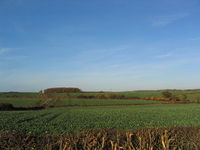
Lincolnshire is an agricultural area, growing large amounts of wheat, barley, sugar beet, and oilseed rape. In South Lincolnshire, where the soil is particularly rich in nutrients, some of the most common crops include cabbages, cauliflowers, and onions.
Mechanisation around the turn of the 20th century greatly diminished the number of workers required to operate the county's relatively large farms, and the proportion of workers in the agricultural sector dropped substantially during this period. Several major engineering companies developed in Lincoln, Gainsborough and Grantham to support those changes, perhaps most famously Fosters of Lincoln, who built the first tank, and Richard Hornsby & Sons of Grantham. Most such companies are long gone, and Lincolnshire is no longer an engineering centre.
Today, immigrant workers mainly from Portugal and from new member states of the European Union in Central and Eastern Europe comprise a very large component of the seasonal agricultural workforce, particularly in the south of the county where more labour-intensive crops such as small vegetables and cut flowers are typically grown. This seasonal influx of migrant labour occasionally causes tension between the migrant workforce and local people, in a county which is still relatively unaccustomed to the large scale immigration experienced by other parts of the United Kingdom. However as a result of the current economic climate some food production facilities have closed down, this has caused some reduction in the levels of migrant workers. The large number of people from Portugal is still very obvious in the town of Boston, and in Grantham the large number of Polish workers is still very apparent.[2][3]
Services and retail
According to an IGGI study in 2000,[4] the town centres were ranked by area thus (including North Lincolnshire and North East Lincolnshire areas):
- Lincoln
- Grantham
- Grimsby
- Boston and Scunthorpe (equal)
- Spalding
- Stamford
- Skegness
- Louth
- Sleaford
- Gainsborough
- Brigg
- Cleethorpes
- Bourne
- Horncastle and Mablethorpe (equal)
Public services
Education
Lincolnshire is one of the few counties within the UK that still uses the Eleven plus to decide who may attend grammar school. As a result, many towns in Lincolnshire have both a Grammar school and a Secondary Modern school. Lincolnshire's rural character means that some larger villages also have primary schools and are served by buses to nearby high schools.
Lincoln itself, however, is primarily non-selective, as is the area within a radius of about seven miles. Within this area, almost all children attend comprehensive schools, though it is still possible to opt into the Eleven plus system. This gives rise to the unusual result that those who pass the Eleven plus can attend a Grammar School outside the Lincoln Comprehensive area, but those who do not pass still attend a non-selective Comprehensive school.
Transport

Being on the economic periphery of England, Lincolnshire's transport links are poorly developed compared with many other parts of the United Kingdom. The road network within the county is dominated by single carriageway A roads and local roads (B roads) as opposed to motorways and dual carriageways – the administrative county of Lincolnshire is one of the few UK counties without a motorway, and until a few years ago, it was said that there was only about 35 km (22 miles) of dual carriageway in the whole of Lincolnshire. The M180 motorway passes through North Lincolnshire, splitting into two dual-carriageway trunk roads to the Humber Bridge and Grimsby, and the A46 is now dual carriageway between Newark and Lincoln.
The low population density of the county means that the number of railway stations and train services is very low in comparison to the county's large area. Many of the county's railway stations were permanently closed following the Beeching Report of 1963. The most notable re-opening has been the line and two stations between Lincoln and Sleaford which re-opened within months of the Beeching closure. Most other closed lines within the county were long ago lifted and much of the trackbed has returned to agricultural use.
A daily through train service operated between Cleethorpes and London King’s Cross via Grimsby, Market Rasen and Lincoln until the late 1980s. The Humberlincs Executive as the service was known was operated by a HST125 unit but was discontinued following the electrification of the East Coast Main Line. Passengers now have to change trains at Newark when travelling to and from London. However, the East Coast Main Line passes through the county and one can catch direct trains to the capital from Grantham. Train operator East Midlands Trains reintroduced a direct Lincoln-London service in December 2008. Running Monday to Saturday, it is essentially a stopping service. The extended route via Newark Castle station, Nottingham station, East Midlands Parkway and London St Pancras takes almost 3 hours. Changing trains at Newark Northgate for a train to Kings Cross can take under two hours. A proposed 2 hourly service promised by National Express East Coast (who lost the franchise on 13 November 2009) between Lincoln and Kings Cross has yet to start running, though was promised to start running by 2010 at the latest. Most rail services are currently provided by East Midland Trains and Northern Rail. East Coast and Cross Country Trains have services which pass through the county, stopping at Grantham and Stamford respectively. Stations along the Humber are served by First Transpennine Express services between Manchester Airport and Cleethorpes. Lincolnshire also boasts one of the most infrequent services in the UK. Services on the Sheffield-Gainsborough Central-Cleethorpes line sees trains only on a Saturday with three trains in both directions. This line is however used for freight. Calls have been made to re-introduce an hourly service on the line.
The only airport in Lincolnshire is Humberside Airport, near Brigg. While small, it serves all of Lincolnshire. Robin Hood Airport near Doncaster and Leeds Bradford International Airport in Leeds are within travelling distance of much of Lincolnshire and provide a wider range of flights.
The county's biggest bus companies are Stagecoach Grimsby-Cleethorpes (formerly Grimsby-Cleethorpes Transport) and Stagecoach in Lincolnshire, the new name for the Lincolnshire Road Car. Several other small companies also operate. Perhaps the best known of these is the Delaine company.
A Sustrans cycle route runs from Lincoln to Boston in the South of the county.[5]
Health care
The United Lincolnshire Hospitals NHS Trust is one of the largest trusts in the country, employing almost 4,000 staff and with an annual budget of over £200 million.
Lincolnshire shares the problems of elsewhere in the country when it comes to finding an NHS dentist, with waiting lists of eight months not uncommon.
Some of the larger hospitals in the county include:
- Grimsby's Diana Princess of Wales Hospital
- Boston Pilgrim Hospital
- Lincoln County Hospital
Since April 1994, Lincolnshire has had an Air Ambulance service[6] which was extended to also cover Nottinghamshire in 1997. The air ambulance is stationed at RAF Waddington near Lincoln and can reach emergencies in Lincolnshire and Nottinghamshire within 25 minutes. From any accident in Lincolnshire an A&E hospital is only 10 minutes away by helicopter.
Drainage
Separately to the commercial water companies the low-lying parts of the county are drained by various Internal Drainage Boards, such as the Black Sluice Internal Drainage Board, Lindsey Marsh Drainage Board, or the Welland and Deepings Internal Drainage Board.[7]
Politics
Parliamentary
| General Election 2010 : Lincolnshire | ||||||||
|---|---|---|---|---|---|---|---|---|
| Conservative | Labour | Liberal Democrats | UKIP | BNP | Others | English Democrats | Green | Turnout |
| 235,502 +63,170 |
122,634 −42,694 |
99,595 +20,063 |
25,018 +2,201 |
18,076 +15,713 |
4,775 +3,764 |
1,121 +347 |
1,120 +39 |
507,841 +62,603 |
| Overall Number of seats as of 2010 | ||||||||
|---|---|---|---|---|---|---|---|---|
| Conservative | Labour | Liberal Democrats | UKIP | BNP | Others | English Democrats | Green | |
| 9 | 2 | 0 | 0 | 0 | 0 | 0 | 0 | |
The Conservative Party won 9 seats in the 2010 General Election and clearly became the largest party in the Lincolnshire, considerably increasing their vote share at the expense of Labour, the most high profile casualty being Gillian Merron who lost her long serving Lincoln constituency.
| Parliamentary Constituencies | |||
|---|---|---|---|
| Constituency | District | MP | Party |
| Boston and Skegness | Boston, East Lindsey | Mark Simmonds | Conservative |
| Brigg and Goole | North Lincolnshire (plus part in East Riding of Yorkshire) | Andrew Percy | Conservative |
| Cleethorpes | North East Lincolnshire, North Lincolnshire | Martin Vickers | Conservative |
| Gainsborough | West Lindsey, East Lindsey | Edward Leigh | Conservative |
| Grantham and Stamford | South Kesteven | Nicholas Boles | Conservative |
| Great Grimsby | North East Lincolnshire | Austin Mitchell | Labour |
| Lincoln | Lincoln, North Kesteven | Karl McCartney | Conservative |
| Louth and Horncastle | East Lindsey | Sir Peter Tapsell | Conservative |
| Scunthorpe | North Lincolnshire | Nic Dakin | Labour |
| Sleaford and North Hykeham | North Kesteven, South Kesteven | Stephen Phillips | Conservative |
| South Holland and The Deepings | South Holland, South Kesteven | John Henry Hayes | Conservative |
Lincolnshire County Council
The Conservative Party comfortably controls the County Council, following the 2009 local elections in which they increased their majority to 43 seats. The Labour Party lost a total of 15 seats including 7 in the City of Lincoln, whilst the Liberal Democrats lost three. The Lincolnshire Independents Party gained a total of four seats, although one of their number moved to the Conservative group during 2010, increasing the number of Conservative seats to 61. The collective group of the Lincolnshire Independents, the Boston Bypass Party and other independent councillors form the opposition for the four year term.
| Overall Number of County Council seats as of 2009 | ||||||||
|---|---|---|---|---|---|---|---|---|
| Conservative | Liberal Democrats | Labour | Lincolnshire Independents |
Other Independents |
Boston Bypass Party |
|||
| 61 | 5 | 4 | 3 | 3 | 1 | |||
Towns and villages
The non-metropolitan county of Lincolnshire is characterised by the absence of any major urban area. The principal settlements and their populations are: Lincoln (100,000), Boston (58,300), Grantham (33,243),[8] Gainsborough (20,110), Skegness (18,910), Spalding (18,731),[8] Stamford (17,492),[8] Louth (17,000), Bourne (11,933), Mablethorpe (11,700), Sleaford (10,388),[8] Holbeach (9,448), Deeping St. James (6,923), Market Deeping (6,200), Horncastle (6,090), Long Sutton (5,037), Sutton Bridge (3,936), Woodhall Spa (3,657), Crowland (3,607), Coningsby (3,238), Market Rasen (3,230), Heckington (3,069), Alford (2,700), Caistor (2,601), and Spilsby (2,336). Other places of interest include Ancaster, Corby Glen, Belmont, Donington, Billingborough, Ingoldmells, Chapel St Leonards, Sutton-on-Sea, Wainfleet All Saints and Donna Nook. Many of the towns in the county continue to hold a weekly market, a centuries-old tradition reinvigorated recently by the growth of farmers' markets.
Most of the urbanised area of Lincolnshire is on the Humber estuary, where two unitary authorities are located:
- North East Lincolnshire, where the two towns of Great Grimsby (90,703) and Cleethorpes (34,907) have become one large conurbation, and between them have a population of over 120,000: the largest single settlement in the whole of the ceremonial county of Lincolnshire. The next largest town is Immingham (12,200) followed by Waltham (6,425) and Humberston (5,375).
- North Lincolnshire has the larger area of the two unitary authority areas and it includes Scunthorpe (75,514) (including Bottesford).[8] The next largest town is Barton-upon-Humber (9,334), followed by Brigg (5,076), Winterton (4,729), Crowle (4,090), Epworth (3,734), Kirton in Lindsey (2,964) and Barrow upon Humber (2,745).
For a full list of Lincolnshire towns and villages see the List of places in Lincolnshire page.
Tourism
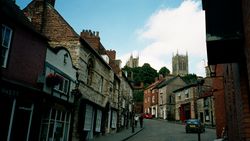
The majority of tourism in Lincolnshire relies on the coastal resorts and towns which lie to the east of the Lincolnshire Wolds. Skegness is a popular UK seaside destination and attracts many visitors. Along with the neighbouring resorts of Ingoldmells, Chapel St Leonards and Mablethorpe, it offers many amusements, leisure activities and beaches. Caravan sites on the Lincolnshire coast are very popular. The market towns of the Lincolnshire Wolds are also attractive, with several having historic links. The wolds are quite popular for cycling and walking, with regular events such as the Lincolnshire Wolds Walking Festival.
Nature is an attraction for many tourists: the south-east of the county is mainly fenland that attracts many species of birds, as do the nature reserves at Gibraltar Point, Saltfleetby and Theddlethorpe.The reserve at Donna Nook also has a native seal colony popular with nature lovers.
Lincolnshire offers shopping facilities in Grimsby and Lincoln, with Lincoln having seen significant development. The Springfields Outlet Shopping Centre in Spalding has been extended to include new shops and a hotel. Lincoln has the attraction of a historic quarter based on Steep Hill with Lincoln Castle and the 900 year old Lincoln Cathedral, as well as a trendier area around the University and at the Brayford Waterfront.
Culture
Lincolnshire is a rural area where the pace of life is generally much slower than in much of the United Kingdom. Sunday is still largely a day of rest, with only shops in Lincoln, larger market towns, and resorts and industrial towns of the North Sea coast generally remaining open. Some towns and villages in the county still observe half-day closing on Thursdays. Due to the large distances between the towns, many villages have remained very self-contained: most still have shops, pubs, local halls and local chapels and churches, offering a variety of social activities for residents. Fishing (in the extensive river and drainage system in the fens) and shooting are popular activities.
Lincolnshire's unofficial county anthem is the Lincolnshire Poacher.
A Lincolnshire tradition is that front doors are used for only three things: a new baby, a bride, and a coffin.[9] This tradition is often referred to by the witches in Terry Pratchett's Discworld novels.[10]
People
Lincolnshire is relatively unusual in the composition of its population, being one of the least ethnically diverse counties of the United Kingdom (98.5% of the population describe themselves as "white"). Over recent years inward migration by people from ethnic minority communities has increased (particularly to population centres such as Lincoln and Boston) but the absolute number of non-white Lincolnshire residents remains very low.
Recently, the county has also witnessed a growing trend towards immigration of retired people from other parts of the United Kingdom, particularly those from the southern counties of England attracted by the generally lower property prices and the slower and more relaxed pace of life. The relatively high proportion of elderly and retired people is reflected in many of the services, activities and events. Sleaford is considered one of the fastest growing towns in the East Midlands, with many professional people moving there to benefit from (relatively) low house prices, average crime rate and the selective education offered.
Those born in Lincolnshire are sometimes given the nickname of Yellowbellies (often spelt "Yeller Bellies", to reflect the pronunciation of the phrase by the typical Lincolnshire farmer). The origin of this term is debated, but is most commonly believed to derive from the uniforms of the 10th Regiment of Foot (later the Lincolnshire Regiment) who wore a very bright yellow waistcoat for identification on the battle field. For this reason, the coat of arms of Lincolnshire County Council is supported by two officers of the regiment.[11]
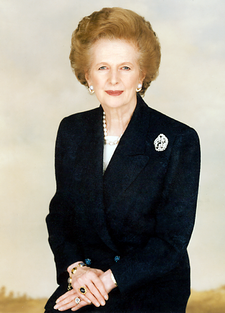
Famous people
Lincolnshire has several famous figures associated with it, notably
- Hereward the Wake
- Little Saint Hugh of Lincoln
- Bishops of Lincoln Hugh of Lincoln and Robert Grosseteste
- Eleanor of Castile
- Katherine Swynford
- King Henry IV of England
- Composer William Byrd
- Chief Advisor to Queen Elizabeth I William Cecil, 1st Baron Burghley
- Scientist Sir Isaac Newton
- Arctic explorer Sir John Franklin
- Plant Collector Joseph Banks
- Navigator and cartographer Matthew Flinders
- Geographer Halford Mackinder
- Explorer of Australia George Bass
- Mathematician George Boole
- Chronometer innovator John Harrison
- Antiquarian William Stukeley
- Artist Peter De Wint
- Journalist Herbert Ingram
- Poets Alfred Lord Tennyson & Elizabeth Jennings
- Bishop and founder of Corpus Christi College, Oxford, Richard Foxe
- Founder of the Baptist denomination John Smyth (Baptist minister)
- Archbishop of Canterbury John Whitgift
- Author of "Foxe's Book of Martyrs" John Foxe
- Puritan John Cotton
- Founders of the Methodist movement John Wesley and Charles Wesley.
- Theologian and Methodist Writer Richard Watson
- Leader of the Jamestown Settlement and associate of Pocahontas, Captain John Smith
- Actor Neil McCarthy
- Actresses Madge Kendal & Sybil Thorndike
- A part of the Music Hall Act Old Mother Riley, Arthur Lucan
- Railway Administrator Frank Pick
- "The Acid Bath Murderer" John George Haigh
- Businesswoman and Welsh Language Translator Lady Charlotte Guest
- Inventor of Crucible Steel Benjamin Huntsman
- Tenor Alfred Piccaver
- Field Marshall William Robertson
- Founder of "The Samaritans" Chad Varah
- Industrialists Joseph Ruston and William Tritton
- R.A.F personnel Douglas Bader, Leslie Manser, Frank Whittle , Guy Gibson
- Historian Francis Hill
- Footballer and Manager Keith Alexander
Present day figures include
- Actors Thomas Turgoose, Jim Broadbent, Jonathan Kerrigan, Neil McCarthy & John Hurt
- Actresses Patricia Hodge, Joan Plowright, Liz Smith, Kelly Adams & Sheridan Smith
- Former Prime Minister Margaret Thatcher
- Actress and comedienne Jennifer Saunders
- Radio and TV presenter Nicholas Parsons
- Crime Writer Colin Dexter
- Astronaut Michael Foale
- Songwriters Bernie Taupin & Rod Temperton
- Military historian and author Bruce Barrymore Halpenny.
- Actor and comedian Robert Webb.
- Musicians Jane Taylor & Neville Marriner
- Golfer Tony Jacklin
- Shotputter Geoff Capes
- Swimmers Paul Palmer & Kate Haywood
- Footballers Lee Chapman & Paul Mayo
- Glamour Model Abi Titmuss
Language
The accent and dialect words of Lincolnshire are little known outside the county, especially compared with more familiar accents, e.g. Geordie and Cockney. The effects of modern media, education, and immigration to the county have substantially diluted the traditional accent, and many dialect words have been lost over recent years. However, the accent exists, and a native "Yeller Belly" will still pick out a Lincolnshire speaker, possibly even being able to distinguish where in the county the speaker is from. The northern residents of Lindsey tend towards the Yorkshire dialect, with the accent of the south-east of the county (Holland and the Fens) being more similar to that of East Anglia.
In common with most other Northern and Midlands dialects in England, "flat" a is preferred, i.e. /ˈbæθ/ over /ˈbɑːθ/, and also in words like water, pronounced /ˈwætər/ watter (though such a pronunciation is rarely heard nowadays). Similarly, /ʌ/ is usually replaced by /ʊ/. Features rather more confined to Lincolnshire include:
- Elaboration of standard English /eɪ/ or /iː/ into a complex triphthong approximating, and often transcribed -air- or -yair-. For example: "mate" [m(j)ɛːət]; "beast" [b(j)ɛːəst]; "tates" (potatoes) [t(j)ɛːəts].
- An equivalent elaboration of standard English /oʊ/ - commonly [oː] in Northern England - into -ooa-. For example "boat" [bʊːət].
- Insertion of an extra schwa into the standard English diphthong /aʊ/.
- Vocabulary: "duck" as a term of endearment or informal address, "mardy" meaning upset or angry, "mowt" (pronounced like mout) for might,"while" as a substitute for standard English "until", "frit" meaning frightened, and the inimitable salutation "now then!?" (hello), sometimes written nairn to reflect pronunciation, but often drawn out into a sing-song nyEEEAaairn-myeeeaaairt!!! in the mouth of the more rural and traditional speaker.
- In the north east of the county, around Grimsby and Immingham, the nurse-square merger can be heard, as is also the case along the east coast of Yorkshire and coincidentally also in Liverpool. Words that take /ɜː/ in RP take /ɛː/ in these areas.
Lincolnshire has its own dialect "champion", a farmer from the village of Minting called Farmer Wink (real name Robert Carlton), who has produced videos about rural life, narrated in his broad Lincolnshire accent, and who has a regular slot on BBC Radio Lincolnshire. A resident of Woodhall Spa, ironically one of the Lincolnshire settlements least aligned to the county's architectural style, has published a dictionary of words once prevalent in parts of the county.[13]
Food
Lincolnshire has a number of local dishes:
- Stuffed chine – this is salted neck-chine of a pig taken from between the shoulder blades, salted for up to ten months and stuffed with parsley stuffing (other ingredients are normally kept secret), and served cold. It is considered by many in the county to be an acquired taste.
- haslet – a type of pork loaf, also flavoured with sage (pronounced HAYSS-let in Lincolnshire but HAZ-let in many other parts of the country).
- Lincolnshire pork sausages – most butchers in Lincolnshire have their own secret recipe for these and a competition is held each year to judge the best sausages in the county. Traditional Lincolnshire sausages are made entirely from minced pork, stale bread crumb (rusk is used nowadays) pepper, sage and salt. The skins should be natural casings which are made from the intestines of either sheep or pig.
- Pork pies – the same pork butchers will take a pride in their unique recipe for pork pies.
- Plum bread – as with plum pudding, plum refers to dried fruit, namely currants, raisins and sultanas, sometimes soaked in tea.
- Grantham Gingerbread – a hard white ginger biscuit.
- Batemans ales – a beer brewed in Wainfleet and served in many pubs in the county and further afield.
- There are several small breweries, such as Newby Wyke Brewery (behind the Willoughby Arms in Little Bytham).
- Grimsby is renowned for its fishing industry, and historically Grimsby Fish has carried a premium price. Since the decline of the fishing industry following entry to the European Economic Community in the 1970s this is no longer the case, with the majority of fish sold at the town's fish market being brought overland from other ports. However Grimsby Fish is still a recognised product, one associated with a particular area that specialises in and has expertise in a particular trade (cf Sheffield steel and Nottingham lace). In 2009 smoked fish from the town was granted Protected Geographical Indication by the European Union, reflecting the unique smoking methods used by certain local fish companies[14].
Events
Every year the Lincolnshire Agricultural Society, founded in 1869, stages the Lincolnshire Agricultural Show.[15] It is held on the Wednesday and Thursday of the last whole week of June at its Showground at Grange de Lings, a few miles north of Lincoln on the A15. The show was first held here in 1958. First held around the year 1884, it is one of the largest agricultural shows in the country, and is attended by around 100,000 people over its two days. The Showground is in regular use throughout the year for a wide range of other events and functions.
Smaller local agricultural shows, such as the Deeping Show[16] or the Heckington Show[17] can still be found. Corby Glen sheep fair[18] has been held every year since 1238.

Each year RAF Waddington is the home to the RAF Waddington Air Show. The two day event attracts around 40,000 people and usually takes place during the last weekend of June.
On the Monday before Easter, an unusual auction takes place in Bourne to let the grazing rights of the Whitebread Meadow.[20] Bidding takes place while two boys race toward the Queen's Bridge in Eastgate, the end of which dash is equivalent to the falling of the gavel. The whole affair dates back to the 1742 will of William Clay.
The Haxey Hood village competition takes place every January, as it has for over 700 years.
Stamford Mid-Lent fair sees showmen converge on the town the week after Mothering Sunday, with rides and sideshows filling Broad Street, the Sheepmarket and the Meadows for a week. Stalls selling Grantham gingerbread and nougat are a traditional feature. The following week sees them in Grantham, on the way North for the Summer. Roger Tuby brings a small funfair to Bourne and then to Spalding in Spring and returns in Autumn at the end of the season.
The villages of Tetford and Salmonby hold an annual Scarecrow Festival in May every year.
The Belchford Downhill Challenge which is held every two years: soapbox racers race down the hill at up to 30 km/h. The turnout has been up to 1,000.
In recent years Lincoln Christmas Market, a street market throughout historic area of the city, has been held at the start of December. Around the same time Christmas lights are turned on in Bourne, Sleaford, Skegness, and other towns.
Throughout the summer the Stamford Shakespeare Company[21] presents the Bard's plays in the open air theatre at Tolethorpe Hall, which is actually in Rutland.
The Spalding Flower Parade is held in late spring every year. Colourful floats decorated with tulip heads compete for a cup. The tradition was started in 1959, and draws coach tours from across Britain. There was talk of 2008 being the last parade, but a smaller event planned for 2009[22] may set the pattern for future years.
Sport
The main sports played in the county are football, cricket and rugby union. Lincolnshire does not have high sporting profile, mainly due to the lack of facilities. Probably the most well known sporting venue in Lincolnshire is Cadwell Park near Louth, where a round of the British Motorbike Championship is held on the last Monday of August every year.
- Two teams from Lincolnshire play in the Football League: Scunthorpe United play in The Championship whilst Lincoln City play in League Two. In non-league football the highest ranked team from Lincolnshire is Grimsby Town who will play in the Conference Premier in 2010/11. Gainsborough Trinity are the next highest team in the league pyramid and play in the Blue Square North Division.
- In cricket Lincolnshire are a minor county and play in the Minor Counties Championship.[23]
- There is no major rugby union team from Lincolnshire; however the sport is played in many schools throughout the county.
- Lincolnshire is home to only one racecourse, at Market Rasen.
- Cadwell Park is the only motor racing course in Lincolnshire. There is a speedway track in Scunthorpe, home of the Scorpions, and stock-car racing at a stadium at Orby, near Skegness.
- Lincolnshire is home to the UK roller derby team the Lincolnshire Bombers Roller Girls, who are sponsored by Motorhead.[24]
Symbols
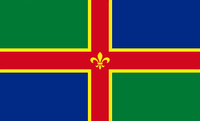
The unofficial anthem of the county is the traditional folk song, "The Lincolnshire Poacher", which dates from around 1776. A version of the song was the theme to BBC Radio Lincolnshire for many years.
According to a 2002 marketing campaign by the charity Plantlife, the county flower of Lincolnshire is the Common Dog-violet.
In August 2005, BBC Radio Lincolnshire and Lincolnshire Life magazine launched a vote for a flag to represent the county. Six competing designs were voted upon by locals. The winning submission was unveiled in October 2005.[25][26] Lincoln has its own flag – St George's flag with a Fleur-de-Lys.
The Lincoln Imp has symbolised Cathedral, City, and county for many years. In 2006 it was replaced as the brand of Lincolnshire County Council by the stylised version seen on the header here [1] which has lost even the unique pose of the carving.
Press
The county is home to three daily newspapers. The Lincolnshire Echo is published from Lincoln and covers the majority of the county, reaching as far north as Louth.
The Grimsby Telegraph, as the name suggests, is published in the town and its circulation area ostensibly covers North East Lincolnshire, although it reaches as far south as Louth and Alford. Its sister title is the Scunthorpe Telegraph and covers North Lincolnshire. All three are ultimately owned by the Daily Mail and General Trust.
There are also a number of weekly papers serving individual towns published in the county by Johnston Press. One of these, the Stamford Mercury claims to be Britain's oldest newspaper, although it is now a typical local weekly and no longer covers stories from the whole East Midlands as the archived copies did.
Television
With the exception of a small area to the south-west of the county,[27] Lincolnshire is served from the Belmont transmitter,[28] receiving programmes from ITV1 Yorkshire and BBC One Yorkshire and Lincolnshire regions.
The BBC has, since 2003, provided the area with its twelfth regional service: BBC Yorkshire and Lincolnshire, carrying a local "Look North" news programme from the main studio in Hull, with input from other studios in Lincoln and Grimsby.
ITV provides coverage through its evening news programme Calendar. Until late 2008 the station provided a separate edition for the Belmont transmitter (although it was still broadcast from Leeds). From January 2009 the area is now covered by a programme that covers the entire ITV Yorkshire region.
From 1959 to July 1974 ITV programmes were provided by Anglia Television (although some coverage could be received from the Manchester-based Granada and ABC Weekend). Based in Norwich the company had news offices in Grimsby.[29] Following a transmitter change ITV services were provided by Yorkshire Television. This company kept open the offices in Grimsby and opened further facilities in Lincoln, although both of these closed in the mid-1990s.
South-West Lincolnshire receives BBC East Midlands and ITV Central which are broadcast from the Waltham on The Wolds Transmitting Station. Although subject to co-channel interference from the Waltham transmitter, a small number of households in the southern tip of the county[30] are able to receive regional programming from BBC East and ITV Anglia.
Radio
The area is covered by several local radio stations including:
- BBC Lincolnshire Can be heard throughout historic Lincolnshire although its broadcast remit is the present county of Lincolnshire
- BBC Radio Humberside The counties of northern Lincolnshire that were formerly known as South Humberside
- Boundary Sound Newark
- Compass FM Grimsby, Cleethorpes and Immingham
- Hereward FM Peterborough
- Lincs FM Historic Lincolnshire
- Priory FM Grantham
- Siren FM Lincoln
- Endeavour FM (formerly Stump Radio) Boston
- Endeavour Online Boston
- Tulip Radio Spalding and South Holland
- Viking FM Northern Lincolnshire and the East Yorkshire, formerly the constituent areas of Humberside
Places of interest
|
|
|
||||||||||||||||||||||||||
See also
- List of companies in Lincolnshire - Current and former companies
- List of monastic houses in Lincolnshire
- Lincs Wind Farm
References
- ↑ "Lincolnshire County Council". Thebythams.org.uk. 2005-10-24. http://www.thebythams.org.uk/localgovernment/lincolnshire-cc/index.html. Retrieved 2010-06-29.
- ↑ www.granthamjournal.co.uk
- ↑ Published on Tue May 13 09:56:11 BST 2008. "UPDATED: Fenland Foods workers to protest - Features". Grantham Journal. http://www.granthamjournal.co.uk/news/UPDATED-Fenland-Foods-workers-to.4075959.jp. Retrieved 2010-06-29.
- ↑ http://www.iggi.gov.uk/towncent/2000/towncentres.txt Archived March 9, 2005 at the Wayback Machine.
- ↑ Sustrans Lincolnshire
- ↑ http://beehive.thisislincolnshire.co.uk/default.asp?WCI=SiteHome&ID=4781&PageID=24114 beehive.thisislincolnshire.co.uk
- ↑ Map of Lincolnshire IDBs
- ↑ 8.0 8.1 8.2 8.3 8.4 Pears Cyclopedia, 107th Edition,Penguin, London
- ↑ Lincolnshire Sayings and Traditions.
- ↑ Equal Rites, Pratchett, 1987.
- ↑ Civic Heraldry visited 22 December 2006
- ↑ Image provided by the Margaret Thatcher Foundation
- ↑ http://www.thisislincolnshire.co.uk/displayNode.jsp?nodeId=156130&command=displayContent&sourceNode=156603&home=yes&contentPK=15658693 thisislincolnshire.co.uk
- ↑ http://www.timesonline.co.uk/tol/life_and_style/food_and_drink/article6919386.ece
- ↑ "Lincolnshire Events Centre". Lincolnshire Showground. http://www.lincolnshireshowground.co.uk. Retrieved 2010-06-29.
- ↑ [email protected] (2010-06-06). "The Deeping Show". The Deeping Show. http://www.deepingshow.co.uk/. Retrieved 2010-06-29.
- ↑ "The Largest Village Show In England". Heckingtonshow.org.uk. http://www.heckingtonshow.org.uk/. Retrieved 2010-06-29.
- ↑ "Corby Glen Sheep Fair Gallery". Corbyglen.com. http://www.corbyglen.com/sheepfair/gallery.html. Retrieved 2010-06-29.
- ↑ "RAF Red Arrows - Home". Raf.mod.uk. 2010-01-11. http://www.raf.mod.uk/reds/. Retrieved 2010-06-29.
- ↑ "The White Bread Meadow". Homepages.which.net. http://homepages.which.net/~rex/bourne/wbmeadow.htm. Retrieved 2010-06-29.
- ↑ "Stamford Shakespeare Company". Stamfordshakespeare.co.uk. http://www.stamfordshakespeare.co.uk/. Retrieved 2010-06-29.
- ↑ "Not the end of Spalding Flower Parade". Spalding Today. http://www.spaldingtoday.co.uk/news/Not-the-end-of-Spalding.4433345.jp. Retrieved 2010-06-29.
- ↑ Play-Sport New Media (2002-06-13). "Play-Cricket the ECB Cricket Network". Lincscb.play-cricket.com. http://lincscb.play-cricket.com/. Retrieved 2010-06-29.
- ↑ "Now sponsored by MOTÖRHEAD! - Lincolnshire Bombers:". Lincolnshire Bombers' News forum. 1st April 2009. http://lincolnshire-bombers.com/sponsorship_motorhead.htm. Retrieved 2010-01-11.
- ↑ "New county flag design unveiled". BBC News. 24 October 2005. http://news.bbc.co.uk/2/hi/uk_news/england/lincolnshire/4371070.stm. Retrieved 2010-02-15.
- ↑ "Lincolnshire flag at the self-appointed flag registry". http://www.flaginstitute.org/index.php?location=10&flagtype=county&flagid=112.
- ↑ Map of area served by the Waltham UHF analogue TV transmitter
- ↑ Map of area served by the Belmont UHF TV transmitter
- ↑ ITV 1968 - A Guide to Independent Television, Independent Television Authority, London, 1967, page 175
- ↑ Map of area served by the Sandy Heath UHF analogue TV transmitter
External links
 |
South Yorkshire | East Riding of Yorkshire | North Sea |  |
| Nottinghamshire | North Sea The Wash |
|||
| Leicestershire | Rutland, Cambridgeshire | Norfolk |
|
|||||||||||||||||
|
|||||